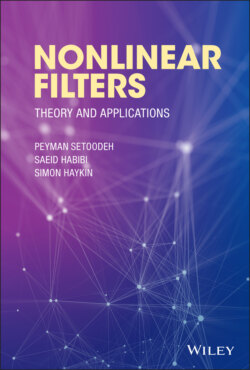Читать книгу Nonlinear Filters - Simon Haykin - Страница 34
3.2 Luenberger Observer
ОглавлениеA deterministic discrete‐time linear system is described by the following state‐space model:
(3.2)
where , , and denote state, input, and output vectors, respectively, and are the model parameters, which are matrices with appropriate dimensions. Luenberger observer is a sequential or recursive state estimator, which needs the information of only the previous sample time to reconstruct the state as:
(3.3)
where is a constant gain matrix, which is determined in a way that the closed‐loop system achieves some desired performance criteria. The predicted estimate, , is obtained from (3.1) as:
(3.4)
with the initial condition .
The dynamic response of the state reconstruction error, , from an initial nonzero value is governed by:
(3.5)
The gain matrix, , is determined by choosing the closed‐loop observer poles, which are the eigenvalues of . Using the pole placement method to design the Luenberger observer requires the system observability. In order to have a stable observer, moduli of the eigenvalues of must be strictly less than one. A deadbeat observer is obtained, if all the eigenvalues are zero. The Luenberger observer is designed based on a compromise between rapid decay of the reconstruction error and sensitivity to modeling error and measurement noise [9]. Section 3.3 provides an extension of the Luenberger observer for nonlinear systems.
